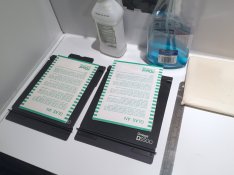I was reading this old thread over at photo.net where someone discusses using polycarbonate to project medium format slides. Got me thinking of all the possible applications, not least of which is as a negative carrier that can be wet mounted upon or wet plates suitable for enlargement.
So has anyone tried this? Thoughts? The idea has me excited as polycarbonate is durable and thin and supposedly transparent.
I sandwich the Velvia slides between polycarbonate strips (1/16th") and slide the strips horizontally through the gate between lens and condenser. I've built a track to hold the strips parallel to the lens barrel and can show four or five 6x6 or 6x7 or 6x8 slides in sequence with no darkening of the screen.
So has anyone tried this? Thoughts? The idea has me excited as polycarbonate is durable and thin and supposedly transparent.












